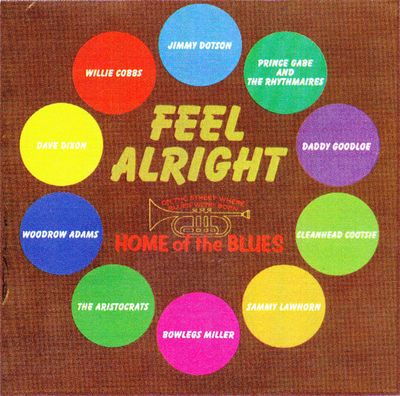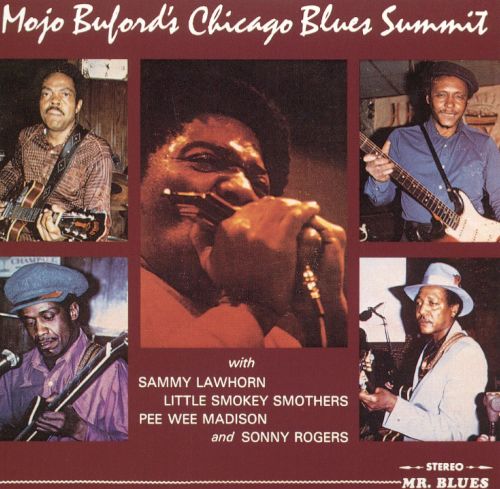Samuel David Lawhorn
b. July 12th, 1935 in Little Rock (Arkansas)
d. April 29th, 1990 in Chicago (Illinois)


FEEL ALRIGHT
P-Vine
ROCKIN' RHYTHM 'N BLUES FROM MEMPHIS
Stomper Time
1960 - 1961
Originaire de l'Arkansas, il est élevé par ses grands-parents après la séparation de ses parents. Précoce, Sammy est capable, dès ses 15 ans, d'accompagner Driftin' Slim puis il joue avec "Sonny Boy" Williamson dans l'émission radiophonique "King Biscuit Time". Il fait aussi la rencontre déterminante de Houston Stackhouse qui lui apprend la technique de la slide-guitare. Entre 1953 et 1958, il sert dans l'U.S. Navy. Il part jusqu'en Corée où il est photographe aérien et sera même blessé par l'ennemi pendant un vol. A son retour, il s'installe à Memphis et reprend sa guitare. C'est, d'ailleurs, dans cette ville qu'il grave son premier morceau, le superbe instrumental "The home of the blues" vers 1960-61 où il démontre toute son habileté technique. Il accompagne aussi Eddie Boyd, Roy Brown, Willie Cobbs (sur son fameux "You don't love me"). Au début des années 60, il déménage à Chicago où il devient un des meilleurs sidemen de la ville. Sammy accompagne alors John Lee Hooker ("Live at Cafe au Go Go"), Otis Spann ("The blues is where it's at") ou Johnny Young ("Fat mandolin"). Mais surtout, dès 1964, il est embauché par Muddy Waters. Il joue alors dans les prestigieuses séances qui donneront "The folk singer", "Real folk blues" et "Can't get no grindin'". Après neuf belles années (jusqu'en 1973), Muddy le licencie à cause de ses fréquents problèmes d'alcool et engage Bob Margolin à sa place.
Originally from Arkansas, he was raised by his grandparents after his parents were separated. Precocious, Sammy is able, from the age of 15, to accompany Driftin' Slim and he plays with "Sonny Boy" Williamson on the radio show "King Biscuit Time". Sam also met Houston Stackhouse who taught him the technique of slide-guitar. Between 1953 and 1958, he served in the U.S. Navy. He leaves to Korea where he is an aerial photographer and will even be wounded by the enemy during a flight. Upon his return, he moved to Memphis and took back his guitar. It is in this city that he cut his first track, the superb instrumental "The home of the blues" circa 1960-61 where he demonstrates all his technical skill. He also accompanies Eddie Boyd, Roy Brown, Willie Cobbs (on his famous "You don't love me"). In the early 1960's, he moved to Chicago where he became one of the best sidemen of the city. Sammy then accompanied John Lee Hooker ("Live at Cafe au Go Go"), Otis Spann ("The blues is where it's at") or Johnny Young ("Fat mandolin"). But especially, from 1964, he was hired by Muddy Waters. He plays in prestigious sessions that will give "The folk singer", "Real folk blues" and "Can't get no grindin'". After nine good years (until 1973), Muddy dismissed him because of his frequent alcohol problems and engaged Bob Margolin in his place.


MOJO BUFORD'S CHICAGO BLUES SUMMIT
Mr Blues
Rooster
P-Vine
February 1979
En mai 1972, alors que sa santé décline à cause de son alcoolisme, il est agressé chez lui par des inconnus qui le poussent par la fenêtre. Sammy en réchappera mais restera lourdement handicapé. Néanmoins, à force de persévérance, il reprendra son métier de guitariste jouant derrière Koko Taylor ("I got what it takes"), Junior Wells ("On tap"), Jimmy Witherspoon ("Spoon's life"), James Cotton ("Take me back"). Lors de cette réunion de bluesmen avec en tête d'affiche l'harmoniciste Mojo Buford, Sammy occupe une place de choix : il chante "Mean old world", dirige l'instrumental "Sammy's shuffle" et délivre quelques beaux solos.
In may 1972, when his health declines because of his alcoholism, he is assaulted at home by strangers who push him out the window. Sammy will survive but will remain severely handicapped. Nevertheless, by dint of perseverance, he will resume his guitarist job playing behind Koko Taylor ("I got what it takes"), Junior Wells ("On tap"), Jimmy Witherspoon ("Spoon's life"), James Cotton ("Take me back"). During this bluesmen meeting with headliner Mojo Buford, Sammy occupies a prominent position : he sings "Mean old world", leads the instrumental "Sammy's shuffle" and delivers some beautiful solos.

AFTER HOURS
Isabel
December 1980
Grâce à Didier Tricard, Sammy Lawhorn peut graver son premier et seul album lors d'une tournée en France. Accompagné de Johnny Dollar (guitare), Nick Charles (basse) et Roosevelt Shaw (batterie), il propose un album presque entièrement instrumental (seulement deux titres chantés) dans lequel brille sa guitare agile et créative. D'après la Blues Discography, il aurait participé à une autre séance à Chicago en 1981. Elle aurait du donner lieu à un disque édité par Gerim mais celui-ci n'a jamais vu le jour.
Thanks to Didier Tricard, Sammy Lawhorn can record his first and only album during a tour in France. Accompanied by Johnny Dollar (guitar), Nick Charles (bass) and Roosevelt Shaw (drums), he proposes an almost entirely instrumental album (only two titles sung) in which shines his agile and creative guitar. According to the Blues Discography, he would have participated in another session in Chicago in 1981. It should have given rise to a record issued by Gerim but it never saw the light of the day.